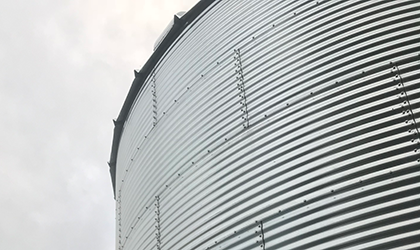September 27, 2018

By Laura Edwards, Nathan Edwards, David Karki, Anthony Bly, Sara Bauder, Ruth Beck, and Jack Davis.
According to the Sept.1 USDA NASS report, South Dakota is heading for bumper row crop production. The USDA NASS predicts the production of corn and soybean crops in South Dakota at a record high of 893 million and 277 million bushels, up 14% and 15% from last year respectively. This year, the record high production and low grain commodity prices may encourage row crop producers in the region to store the grain and wait for a better market. In addition, the current tariff and trade discrepancies may further force producers to hold their grain longer than usual in hope of favorable future trade conditions.
Quality storage starts with harvest
Grain storage begins with harvest, as drying and storage go hand-in-hand. Usually artificial drying allows:
harvesting when the crop is ripe and mature, and
proper storage that preserves seed quality.Even though storage will not necessarily improve the quality of the harvested grain, it helps maintain the existing quality. Harvesting at a proper moisture level is important, but so is reducing handling and mechanical breakage of the seed/grain where possible.
Grains harvested at ideal temperatures may allow for temporary storage without further drying, however, the recent rain and cooler temperatures on the horizon may not provide that option of drying down naturally to the right moisture content. The ideal moisture for soybean harvest is 13 to 15 percent. Soybeans can be harvested as soon as seeds are mature and foliage is dry, but seed above 18% moisture does not thresh well.
Grain drying
When storing grain for extended periods of time (such as many months to a year), it is important to dry the grain quickly, and minimize humidity and temperature fluctuations in the bin. Controlling humidity and temperature is key to ensuring grain quality for many months, which will 1) minimize mold due to excess moisture and 2) minimize cracking due to high heat or conditions that are too dry. Soybeans are often more fragile than corn and may be susceptible to more cracking of seed coats or the seed itself.
Many newer bins have technology that can monitor conditions both inside and outside of the bin, and may even have switches to operate fans when needed. Without this technology, however, it is up to the grower to ensure that grain is stored in ideal conditions. Although uncommon, a fan cover can be a simple addition to any bin; covers help reduce temperature fluctuations due to air brought into bins by wind. This can prolong grain storage by maintaining cool temperatures, especially in long-term storage situations. Roof vents are equally important in maintaining bin temperature to allow hot air above the grain to escape which can help prevent the grain from increasing in temperature.
For long-term storage, the ideal moisture content is 11% for soybeans, 13% for corn. These recommendations are lower than typical harvest or market moisture, but they will help regulate temperature and minimize mold growth and pest infestations while preserving grain quality. A 10°F decrease in temperature can approximately double the number of days the grain will remain in good condition in storage with humidity staying the same.

Natural air, Low temperature, or high temperature drying?
There are three ways to dry grain: using natural (unheated) air or by high or low temperature dryers. North Dakota State University Extension (1) suggests that soybeans can be natural air dried after harvest in October to about 12% moisture content. From mid-October to mid-November, natural air drying can reduce soybeans to about 13% moisture content.
After using natural air drying to 12%, low temperature drying can be used to increase the temperature by 5 degrees to dry the grain to 11% for long term storage. When reaching moisture levels below 11%, damage to the seed and seed coat is likely to occur. Once the ideal moisture content is achieved, these conditions should be maintained in the bin.
Seed soybeans should not be dried at temperatures above 100°F as it will affect their germination. Care should be taken with temperatures above 110°F with a batch dryer. For a continuous flow dryer, temperatures above 130°F should be avoided. Soybeans are more sensitive to high drying rates. Research has shown that seed coat and seed breakage occurs more often at high temperatures, with as much as 50-90% breakage.
Equilibrium Moisture Content (EMC)
Another important factor to consider is Equilibrium Moisture Content (EMC), which is the retained moisture content by the grain when exposed to specific temperature and relative humidity (RH) for a prolonged period. High temperature in a low RH environment dries the grain faster. A good technical reference for EMC can be found at University of Arkansas Research & Extension (2). These tables can help determine if some heating will be effective to reduce moisture to meet the EMC necessary for long-term storage.
Maintaining quality in the long term
Stored soybeans should be aerated to maintain a grain temperature of 35-40°F in the winter (assuming about 60% relative humidity), and 40-60°F in the summer. In warm weather, bins should be checked once a week for heating or spoilage. In cold weather, every two weeks is sufficient. (3)
Moisture and aeration for temperature control are key players in long-term grain storage. Gaining an understanding of the factors listed above can help reduce spoilage and prolong storage during difficult economic times that producers may face this fall and winter.
Check out Part I here, Part II and Part IV her.
You May Also Like




